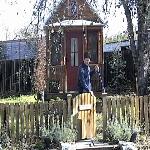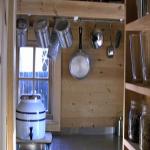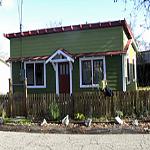14 January 2011

Photo: VOA - S. Schlender
Jay Shafer's first tiny home was under nine square meters and now he helps others downsize as well.
The home foreclosure crisis highlighted how many Americans were in homes that were too big for them and their budget. That may be a reason that interest is growing in smaller - even tiny - homes.
When Jay Shafer was a boy, he hated his 370-square-meter home.
"It was my sister and I who cleaned our house every weekend," he says, "and we envied the other kids who got to play while we cleaned the house all weekend long."
Tiny home
Today, Shafer heads up Tumbleweed Tiny Homes and designs houses that are a fraction of the size of his childhood home. He says smaller is more ecological.
"I don't want to burn any more fossil fuels or go through any more construction materials than I have to, for space that I'm not going to use anyway. And I don't want to be putting out any more greenhouse gases than I have to."
Shafer feels living tiny expands his personal happiness.
"The more stuff I have in my life that's not contributing to my happiness, the more work I have to do, which doesn't make me happy," he says. "So, I got rid of all my unnecessary stuff and just live with what really makes me happy. That editing process is really arduous. But once it's done, that's the hard part. It's all over and you're just living very liberated from there on out."
Shafer's first tiny home is under nine square meters and is just off a shady country lane. The house includes a bathroom with a toilet and shower, a kitchen with a gas stove and sink and an upstairs bedroom loft. There are also amenities such as hardwood floors, a fireplace, a porch, and a gabled roof. Shafer's desk and laptop computer serve as his combination office and TV room.

VOA - S. Schlender
The kitchen in Jay Shafer's tiny home includes a small gas stove and sink .
"That serves as my entertainment center and my link to the outside world, so I really am not missing anything here," he says.
Living small
But while this tiny house was home for nearly a decade, Shafer says things changed, a little, when he got married.
"My wife insisted on something a little bigger, so we bought a relatively palatial [46 square meter] house. Then we had a baby, so it's probably a good thing that we have a little extra space. I actually would not want to live in this house with three people."
The 1950s-era home Shafer now shares with his wife, Marty, and baby Emerson, is five times bigger than his first Tumbleweed home. Still, it's nearly five times smaller than the typical American house.

VOA - S. Schlender
Jay Shafer moved to a bigger house once he married and had a child. His current home is 46 square meters.
But Marty says it's big enough. "The size itself is okay, but maybe just the proportions of the rooms, and the eating area would be a little different."
With her husband's designs, Marty says she might be comfortable down-sizing a bit. Nationwide, more than 300 people have done just that, thanks to Shafer's tiny house plans and workshops where he teaches anyone how to build one.
Do it yourself
The cost for a pre-fab tiny home - not including land to build it on - is around $50,000, one-fifth the cost of the average U.S. home. And the more construction the homeowner does, the lower the cost.
"I'm not a builder by trade. I work in a library, I'm all about books," says Jewels Hall-Payne has just moved into a 16-square-meter tiny home that she built with her partner Molly Hall-Payne. The house sits next to a cornfield in Colorado. "We had to do the research and take a lot of time and ask a lot of questions."
Molly says many people lent a hand on this project. Her mother helped put paneling on the walls.
"There's something about being in a house that was built with a lot of love and friendship," says Molly. "Sure it's small, it's tiny. It's supposed to be but we're happy with how it feels."
Small may be the next big thing in the United States. The National Association of Homebuilders reports that in 2009, the average new home was slightly smaller than those built a few years earlier. More than 50 designers and builders specialize in tiny houses. And every day, thousands of Internet users visit an on-line community Shafer co-founded, called the Small House Society, for ideas and advice about down-sizing.
Shafer says his personal experience helps him understand why living smaller is gaining a bigger audience.
"I don't have to work all the time to make money, to pay for more space than I really need to be happy. So now I just do what I love to do."
And with so many people wanting to know more about the small house movement, these days, Shafer says, what he loves most is to develop designs for more tiny homes.